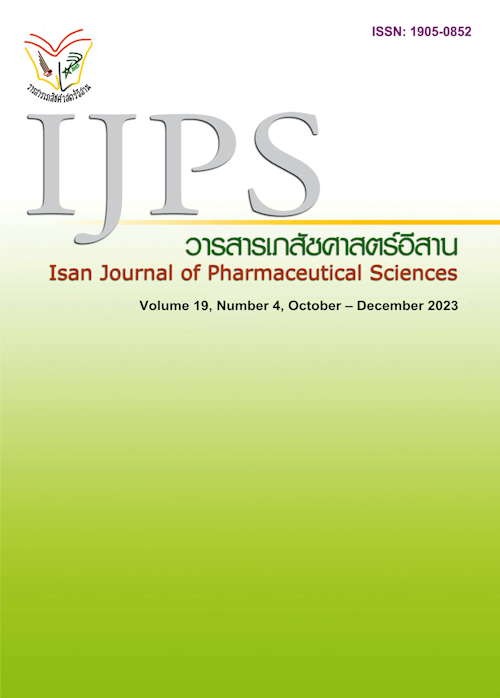The Development of Modern Drugstores for Packaged Non-Dangerous or Non-Specially Controlled Drugs (Type 2) to Comply with The Good Pharmacy Practice (GPP) Standards in Udon Thani Province
Main Article Content
Abstract
According to the Notification of Ministry of Public Health on Good Pharmacy Practice (GPP) Criteria in Type 2 Drugstores, all Type 2 drugstores need to be compliant and pass the assessment for license renewal. The objectives of this research were to survey the situation of Type 2 drugstore entrepreneurs’ knowledge & understanding and readiness according to the GPP criteria, and the results from implementing the development guidelines with participation. Methods: This participation action research (PAR) for developing all 40 Type-2 drugstores in Udon Thani Province used the PAOR cycle in 4 steps: Planning, Acting, Observing, and Reflecting. The data on consistency between self-assessment of entrepreneurs and officers were collected by using the GPP assessment form in 5 categories. The data were analyzed by using the Kappa statistics, and the mean comparison between before and after receiving the development guidelines was performed by using paired t-test. Furthermore, qualitative data were gathered through focus group discussions to collaboratively determine the guidelines through validation of data triangulation, and content analysis was used for data analysis. Results: According to the self-assessment, knowledge and understanding of Type 2 drugstore entrepreneurs were different from the officers at the fair consistency level to the inconsistency level. Regarding the drugstore readiness according to GPP criteria, Category 3 of personnel was at the highest readiness level while Category 4 of drug quality was at the least readiness level. The problems mostly found were entrepreneurs’ incorrect knowledge and understanding about the assessment criteria and drug laws, and difficulty to access necessary information. Accordingly, the guidelines for development were determined to 1) arrange meetings for participatory development of the drugstores according to the GPP criteria, 2) support documents, and 3) arrange an online channel for giving advice through Line Official. After exchanging opinions in the focus group, the entrepreneurs agreed for the development guidelines to be in the same standards throughout the province, and the drugstores would manage to be compliant within 2 months. The results of the development showed that the drugstores’ mean score of each category and the total mean score of 5 categories increased with statistical significance (p < 0.05). Conclusion: The drugstore development with participation in all steps can create understanding, exchange opinions together, and closely give advices through the online systems. As a result, all Type 2 drugstores are successfully compliant to the GPP criteria. These development guidelines can be further applied effectively in other contexts of areas.
Article Details

This work is licensed under a Creative Commons Attribution-NonCommercial-NoDerivatives 4.0 International License.
In the case that some parts are used by others The author must Confirm that obtaining permission to use some of the original authors. And must attach evidence That the permission has been included
References
Chuntaravichit U. Development model to upgrade good pharmacy practice (GPP) standards in drug store Singburi. SHJ. 2020; 29: 119-28.
Dhanasilangkura W. Strategies in Strengthening Drugstores to Fulfill Good Pharmacy Practice in Udon Thani. TJPP. In press 2024.
Drug Act, B.E. 2510. Royal Gazette No. 84, Part 101 special (Oct 20, 1967).
Kemmis, S., & McTaggart, R. (1992) The Action Research Planner (3rd ed.). Geelong: Deakin University Press.
Medicines Regulation Division of Food and Drug Administration Thailand. Statistics of pharmaceutical business licenses 2022. [Online]. [cited 2023 March 10]. Available from: https://www.fda.moph.go.th/sites/drug/Shared%20Documents/Statistic/Licensee-20221223.pdf.
Notification of Food and Drug Administration on Criteria, methods and conditions for passing the assessment according to Good Pharmaceutical Practices regulation. B.E. 2016. Royal Gazette. No.133, Part 123D Special (May 27, 2016).
Notification of Food and Drug Administration on the renewal of a Drug license Narcotics drug in category 3 Psychotropic Substances in category 3 or 4 for using in 2023. (Sep 23, 2022).
Notification of the Ministry of Public Health on Determine the number of premises for selling Packaged modern medicines that are not Dangerous drugs or Specially Controlled Drugs in each province. B.E. 2005. Royal Gazette. No.122, Part 25D Special (Mar 23, 2005).
Notification of the Ministry of Public Health on places equipment and methods of community pharmacy in a place that sells packed modern medicines that are not dangerous drugs or specially controlled drugs according to the Drug Law, B.E. 2021. Royal Gazette. No.138, Part 281D Special (Nov 16, 2021).
Pasunon P. Evaluation of inter-rater reliability using Kappa statistics. Journal of Faculty of Applied Arts, King Mongkut’s University of Technology North Bangkok. 2015; 8: 2-20.
Public Health Ministerial Rule in 2013 on license application and licensing of modern drug selling. Royal Gazette No.130, Part 126A (Dec 27, 2013).
Sombutpoothon P, Reamrimmadun Y, Polnok A. Participatory action research on the empowerment of modern drugstores for packaged non-dangerous or non-specially controlled drugs in Chonburi. TJPP. 2023; 15(2): 347-359.
Sombutpoothon P. Factors on drug store with good pharmacy practice to abide the criterion of the quality pharmacy at Chonburi province [master thesis]. Pitsanulok: Naresuan University; 2021.
The Office of Community Pharmacy Accreditation Thailand. History of Community Pharmacy Development. [online] 2023 [cited Jul 7, 2023]. Available from: https://papc.pharmacycouncil.org/index.php?option=aboutus&subpage=history.
Thongyoung P, Komwuthikarn K. Development of drugstores to good pharmacy practice by participatory action research in Samutsongkhram Province. Thai Food and Drug Journal. 2018; 25: 39-48.
Wientong P, Chinwong D, Chinwong S, Vacharachaisurapol P, Dutjanuthat A, Supakul S. Readiness among community pharmacists in Chiang mai to comply with the ministerial declaration on licensing and requirements on premises, instruments and good pharmacy practice. TJPP. 2017; 9(1): 92-102.


